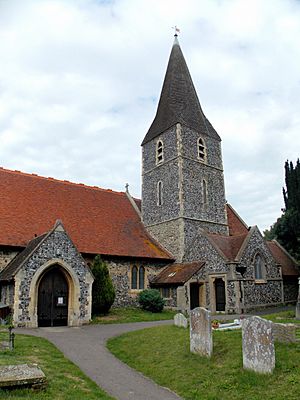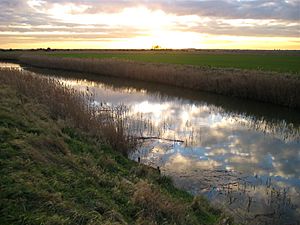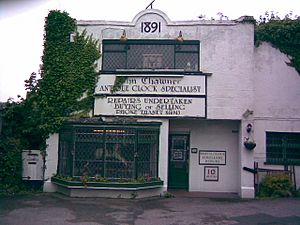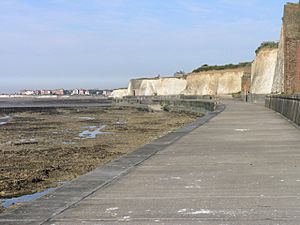Birchington-on-Sea facts for kids
Quick facts for kids Birchington-on-Sea |
|
|---|---|
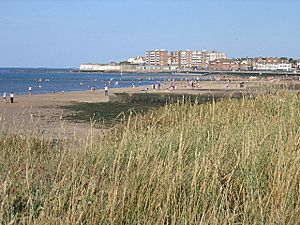 Minnis Bay |
|
| Population | 9,961 (2011 Census) |
| OS grid reference | TR298694 |
| Civil parish |
|
| District |
|
| Shire county | |
| Region | |
| Country | England |
| Sovereign state | United Kingdom |
| Post town | BIRCHINGTON |
| Postcode district | CT7 |
| Dialling code | 01843 |
| Police | Kent |
| Fire | Kent |
| Ambulance | South East Coast |
| EU Parliament | South East England |
| UK Parliament |
|
Birchington-on-Sea is a lovely village located in Kent, England. It's part of the Thanet area and is home to nearly 10,000 people. This coastal village sits right on the North Sea, between the popular seaside towns of Herne Bay and Margate.
Birchington is a great spot for holidays and for people who want to enjoy a peaceful retirement by the sea. Its main beach, Minnis Bay, is perfect for families. You can go sailing, windsurfing, or just relax by the paddling pool. There are also lovely walking paths along the coast. Birchington has three smaller beaches too, surrounded by cool chalk cliffs and caves.
The village has a long history, first mentioned way back in 1240. Its old church, All Saints', was built in the 1200s. A famous artist from the 1800s, Dante Gabriel Rossetti, is buried in its churchyard. Quex Park, a large manor house nearby, has a museum with amazing collections.
The Powell-Cotton Museum at Quex Park is filled with stuffed animals from Africa. These were collected by Major Percy Powell-Cotton on his adventures. The museum also has ancient items found around Birchington by his daughter, Antoinette.
Contents
Discover Birchington-on-Sea's Past
Birchington was first called "Birchenton" in 1240. This name comes from old English words meaning "a farm where birch trees grow." We know people lived here even before the village existed. Roman and prehistoric tools have been found, and Minnis Bay was once an Iron Age settlement.
The village's All Saints' Church was built around 1350. In the early 1400s, Quex Park manor house was built south of the village. It was named after its second owner, John Quek. The house changed hands many times until the Powell family bought it in 1770. Even King William III visited the house in the late 1600s.
In 1565, a report to Queen Elizabeth I said Birchington had 42 houses. It didn't have a busy port back then. Before the 1800s, smugglers often used the coastline. They would hide illegal goods, and sometimes fought with officers. Many old houses in the village still have secret cellars and hidden tunnels from those days.
In 1801, the village had 537 people living there.
In the early 1800s, the old Quex House was taken down. A new manor house was built in its place. In 1818, the Waterloo Tower was added to Quex Park. It's a bell tower built by John Powell Powell, who loved change ringing bells. It was the first tower in Kent with twelve bells. Birchington was mainly a farming village until the late 1800s. Then, it started to become a popular seaside resort.
Birchington railway station opened in 1863. The Railway Hotel, now called the Sea View Hotel pub, opened in 1865. Station Road became the main shopping street. Coast Guard cottages were built at Minnis Bay in the 1870s. The first shops appeared by the bay in 1903.
Where is Birchington Located?
Birchington-on-Sea is in northeast Kent, right on the coast of the Thames Estuary. It's about 14 kilometres (9 miles) east of Herne Bay. It's also 6 kilometres (4 miles) west of Margate. The small town of Westgate-on-Sea is between Birchington and Margate.
The village has four partly sandy bays. Minnis Bay is to the west. Grenham Bay and Beresford Gap are in the middle. Epple Bay is to the east. Birchington is on the Isle of Thanet. This used to be a separate island from Kent. But about 200 years ago, the channel between them filled up with silt. The area west of the village was once part of this channel. Now, it's low marshland. To the east, the land rises into chalk cliffs. A sea wall protects the cliffs from erosion.
The land in Thanet is mostly chalk. This chalk formed when the area was under the sea. The Isle of Thanet became dry land when the English Channel opened up. The entire northeast Kent coast is a Site of Special Scientific Interest. This means it's a special place for nature.
The drinking water in the village is "very hard." This is because it comes from underground chalk sources.
Birchington's Weather
In East Kent, the warmest months are July and August. Temperatures usually reach around 21 °C (70 °F). The coolest months are January and February. Temperatures average around 1 °C (34 °F). East Kent is a bit warmer than the national average. The area gets about 728 millimetres (29 inches) of rain each year. The wettest months are from October to January.
Who Lives in Birchington?
| 2011 UK census | Birchington | Thanet | England |
|---|---|---|---|
| Total population | 9,961 | 134,186 | 53,012,456 |
| White | 96% | 91% | 86% |
| Asian | 1.7% | 5% | 8% |
| Black | 0.7% | 1.6% | 3.4% |
| Christian | 61% | 60% | 59% |
| Muslim | 0.9% | 2.3% | 5% |
| Hindu | 0.5% | 1% | 1.5% |
| No religion | 29% | 28% | 25% |
| Over 65 years old | 21% | 17% | 16.4% |
In 2011, Birchington had 9,961 residents. There were 4,944 homes. Many homes were married couples living together. A good number were also single people living alone. For every 100 females, there were about 86 males.
The village has more residents over 65 than the national average. Most people in Birchington are white. Over 95% were born in the UK or other Western European countries. About 61% of residents said they were Christian. About 29% said they had no religion.
What Jobs Do People Do?
In 2011, many people in Birchington worked full-time. Others worked part-time or were self-employed. Some were retired, and this number was higher than the national average.
Many people work in shops, healthcare, and social work. Construction and education are also common jobs. As a seaside town, tourism is important. There are hotels, caravan parks, and fun places to visit. The shops in the village centre are busy with tourists.
The large number of older people means there are many jobs in care homes. There are also jobs at the Birchington Medical Centre. Many residents travel outside the village for work.
Fun Things to Do in Birchington
Minnis Bay is a popular family beach. You can go sailing or windsurfing. There are cafes, beach huts, and places to eat. Kids love the playground and paddling pool. You can also walk or cycle along the coast. The beach has a European Blue Flag Award for being clean and safe.
Birchington has three other smaller beaches. They are surrounded by cool chalk cliffs. You might even spot seals or velvet swimming crabs in the Thames Estuary.
Local artists show their paintings at the David Burley Gallery in Birchington Library.
The Centre Birchington (Birchington Village Centre) hosts many community events. You can find adult education classes and plays by the Birchington Guild of Players. The Birchington Silver Band also performs concerts there.
Since 1989, Birchington-on-Sea has been twinned with La Chapelle d'Armentieres in France. The Birchington Twinning Association organizes events between the two places. These include school trips and concerts.
Every summer since 1932, Birchington has a street carnival.
Sports and Clubs
Birchington has several sports teams. The Birchington United Services Club has a football team and a netball team. The Birchington Chess Club plays in the Thanet League.
The Westgate and Birchington Golf Club has an 18-hole course. It's located on the cliff tops between Westgate and Birchington.
The Birchington Bridge Club meets twice a week. There's also a football pitch at the Birchington Recreation Ground.
For water sports, Minnis Bay Sailing Club is popular. It started in 1950. Members can sail for fun, and competitions are held most weekends. If you like speed boats or jet skis, you can launch them at Beresford Gap. The Beresford Wakeboard and Water Ski Club helps keep things safe there. Anglers can join the Birchington Sea Angling Society.
Local Media
There are two local weekly newspapers for the Thanet area. The Isle Of Thanet KM Extra is free. The Isle of Thanet Gazette you pay for. There are also two local magazines just for Birchington: The Birchington Roundabout and The Birchington Forum.
You can listen to KMFM Thanet on 107.2FM. Community radio station Academy FM (Thanet) started in 2010 on 107.8FM. More recently, Birchington Together CIC started a monthly magazine called Birchington Buzz. In 2017, a local journalist started The Isle of Thanet News online.
Groups for Young People
Birchington has many groups for children and young people. Brownies, Girl Guides, and Scouts are very popular.
There has been a youth club in Birchington since the 1960s. It was simply called "Birchington Youth Club." In 2017, its name changed to "Target Youth Hub." It's run by a local group and led by Youth Worker Melanie Megson.
Quex House and Park
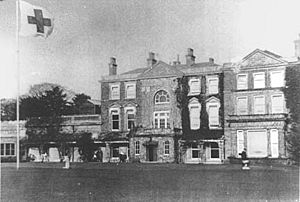
South of the village is Quex House. It's a 200-year-old manor house set in 250 acres of parkland and gardens. You can visit some of its rooms, which are decorated with old furniture. Guided tours are available.
The Powell-Cotton Museum inside Quex House is amazing. It has three galleries with stuffed animals. You can see over 500 African and Asian animals in displays that look like their natural homes.
Other galleries show a huge collection of African items. There are also old European firearms, cutting weapons, and beautiful porcelain. Important ancient finds from Thanet are also on display. There are about 18,000 items just in the ethnography collection!
Percy Powell-Cotton was born in 1866. He was a Major in the Northumberland Fusiliers. He went on scientific trips that sometimes lasted 18 months. In 1896, he started the Powell-Cotton Museum. He wanted to show off the animals and items he collected in Africa and Asia. The famous taxidermist Rowland Ward prepared the animals.
During World War I, Quex House became a military hospital. It was run by local volunteers. In 1923, Mr H. A. Erlebach gave some land to the village for sports. He owned a school nearby and bought land from Quex House. He gave the southern part to the people of Birchington. He dedicated it to his three sons who died in World War I. Now, Thanet District Council owns the land.
Learning in Birchington
Birchington-on-Sea has a secondary school called King Ethelbert School. In 2006, it had about 750 students. Many secondary students from Birchington go to schools in nearby towns. This includes the grammar schools in Ramsgate and Broadstairs.
The village's primary school is Birchington Church of England Primary School. It's a state school run by Kent County Council.
Getting Around Birchington
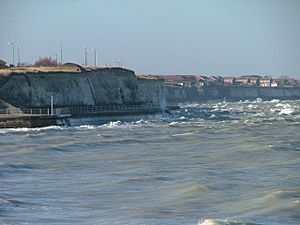
Birchington-on-Sea railway station is on the Chatham Main Line. This line runs between Ramsgate and London Victoria. Other towns on this line include Margate and Herne Bay. Birchington is about 1 hour and 40 minutes from London by train.
A National Express coach service also runs between London and Ramsgate, stopping in Birchington. Some early morning and evening trains go to London's Cannon Street station. There are also high-speed services to St Pancras International.
Stagecoach South East buses run to Westgate-on-Sea, Margate, Broadstairs, Canterbury, and Herne Bay. The A28 road connects Hastings and Margate. It passes through Ashford, Canterbury, Birchington, and Westgate-on-Sea. Southwest of Birchington, the A28 crosses the A299 road. This road leads towards London and becomes the M2 motorway at Faversham.
Famous People from Birchington
Some interesting people have lived in Birchington-on-Sea. Tudor Gates, a British screenwriter, lived here. He wrote films about female vampires in the 1970s. He passed away in the village in 2007.
In 1882, the famous artist and poet Dante Gabriel Rossetti rented a bungalow in the village. He was trying to get better from an illness. Sadly, he died in April that year. He was buried in the churchyard of All Saints' Church. His tombstone was designed by his friend, artist Ford Madox Brown. Composer Rosalind Ellicott is also buried in the Birchington-on-Sea churchyard near her parents.
Images for kids
-
Quex House as an Auxiliary Military Hospital during World War I
-
A view of Birchington-on-Sea from the neighbouring town of Westgate-on-Sea



